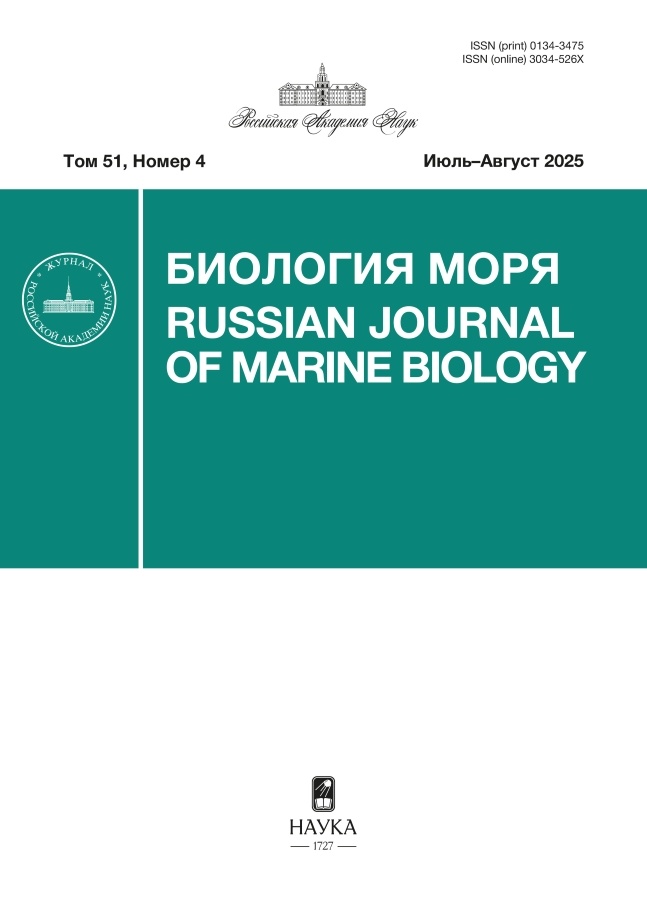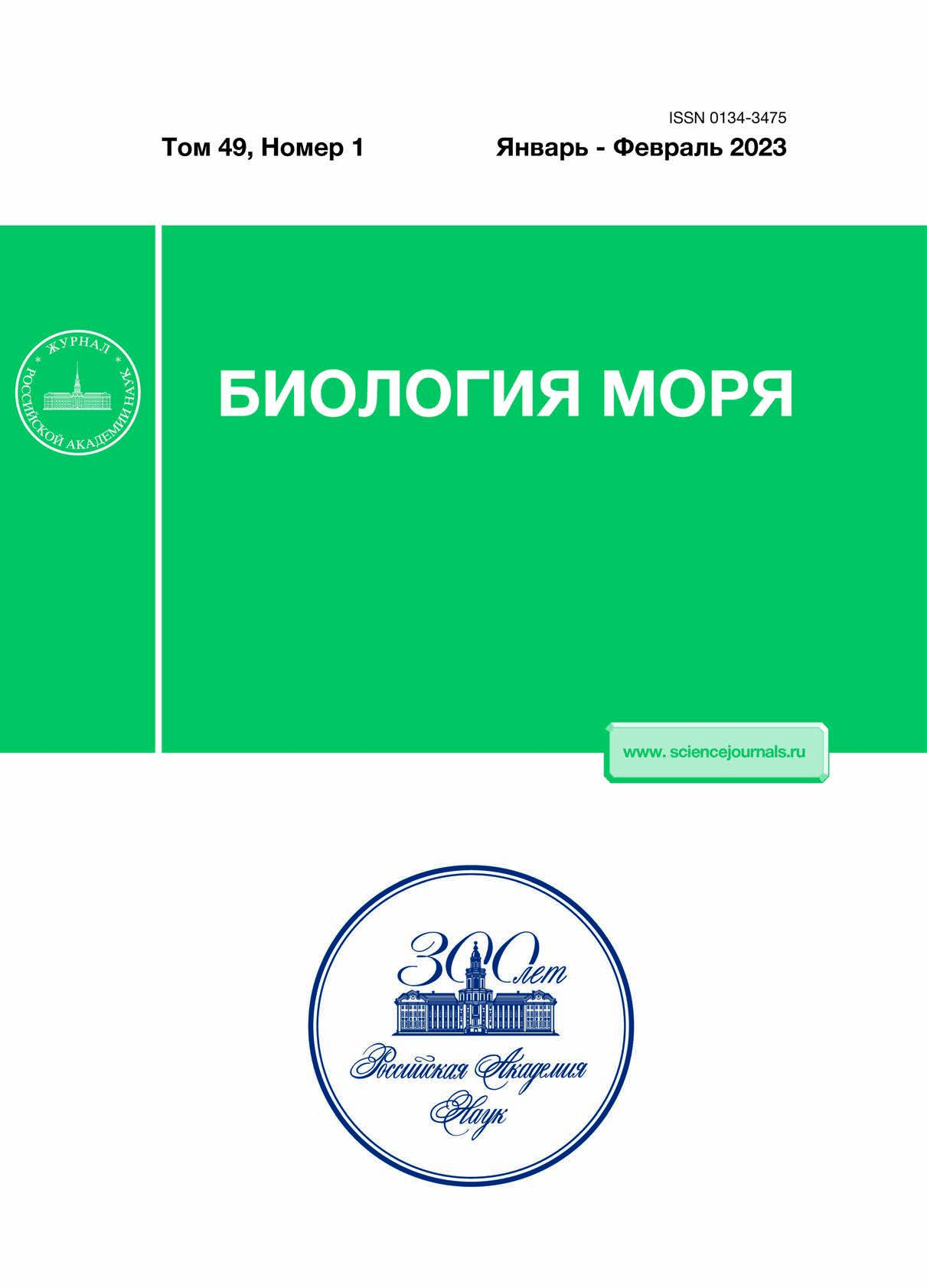Оценка пространственной неоднородности условий культивирования тихоокеанской устрицы Magallana gigas (Thunberg, 1793) с помощью модели управления марифермами FARM в бухте Воевода (Японское море)
- Авторы: Катрасов С.В.1, Бугаец А.Н.1, Жариков В.В.1
-
Учреждения:
- Тихоокеанский институт географии ДВО РАН
- Выпуск: Том 49, № 1 (2023)
- Страницы: 37-44
- Раздел: ОРИГИНАЛЬНЫЕ СТАТЬИ
- Статья опубликована: 01.01.2023
- URL: https://cardiosomatics.orscience.ru/0134-3475/article/view/670285
- DOI: https://doi.org/10.31857/S0134347523010059
- EDN: https://elibrary.ru/LRWITV
- ID: 670285
Цитировать
Полный текст
Аннотация
В настоящем исследовании с помощью модели управления ресурсами аквакультуры на фермах FARM (Farm Aquaculture Resource Management) рассчитана потенциальная продуктивность плантаций устрицы Magallana gigas (Thunberg, 1793) (Bivalvia: Ostreidae) в б. Воевода (Японское море, зал. Петра Великого, о-в Русский). При расчете продуктивности садковых и придонных плантаций M. gigas использовали полученные ранее результаты численного моделирования динамики гидрологических параметров бухты с помощью открытого программного комплекса Delft3D-Flow с учетом притока пресной воды в бухту в 1990–2019 гг. Для демонстрации неоднородности условий выращивания M. gigas были выбраны три участка размером 100 × 100 м, расположенные в бухтах Круглая и Мелководная, а также в центральной части б. Воевода. Для каждого участка выполнено моделирование 28 периодов выращивания, продолжительностью 22 мес. каждый. Выбраны максимальные значения урожайности устрицы на второй год выращивания, выраженные в тоннах общей сырой массы, и представлены гистограммы распределения для каждого района. Показано, что по гидрологическим и биологическим показателям условия выращивания даже в небольшой по размерам б. Воевода неоднородны. Установлено, что вариабельность продуктивности M. gigas связана преимущественно с крайней неравномерностью перераспределения первичной продукции в б. Воевода под воздействием гидродинамических факторов.
Ключевые слова
Об авторах
С. В. Катрасов
Тихоокеанский институт географии ДВО РАН
Автор, ответственный за переписку.
Email: biolm@imb.dvo.ru
Россия, 690041, Владивосток
А. Н. Бугаец
Тихоокеанский институт географии ДВО РАН
Email: biolm@imb.dvo.ru
Россия, 690041, Владивосток
В. В. Жариков
Тихоокеанский институт географии ДВО РАН
Email: biolm@imb.dvo.ru
Россия, 690041, Владивосток
Список литературы
- Барабанщиков Ю.А., Тищенко П.Я., Семкин П.Ю. и др. Сезонные гидролого-гидрохимические исследования бухты Воевода (Амурский залив, Японское море) // Изв. ТИНРО. 2015. Т. 180. С. 161–178.
- Бугаец А.Н., Катрасов С.В., Жариков В.В. и др. Вероятностно-статистическая оценка потенциальной продуктивности марикультуры (на примере бухты Воевода, юг Приморского края) // Докл. Рос. акад. наук. Науки о Земле. 2022. Т. 503. № 1. С. 104–107.
- Гаврилова Г.С. Приемная емкость аквакультурной зоны залива Петра Великого (Японское море): Автореф. дис. … докт. биол. наук. Владивосток: ТИНРО-Центр. 2012. 37 с.
- Гаврилова Г.С., Ким Л.Н. Эффективность культивирования приморского гребешка (Mizuhopecten yessoensis) в Уссурийском заливе (Японское море) // Изв. ТИНРО. 2016. Т. 185. С. 240–250.
- Гаврилова Г.С., Кондратьева Е.С. Результаты хозяйственной деятельности и проблемы развития марикультуры залива Посьета (Японское море) в 2000–2015 гг. // Изв. ТИНРО. 2018. Т. 195. С. 229–243.
- Гаврилова Г.С., А.В. Кучерявенко. Продуктивность плантаций двустворчатых моллюсков в Приморье. Владивосток: ТИНРО-Центр. 2011. 113 с.
- Гайко Л.А. Современные подходы к прогнозированию урожайности гидробионтов в хозяйствах марикультуры с учетом климатических факторов // Науч. тр. Дальрыбвтуза. 2017. Т. 43. № 4. С. 5–11.
- Иванов Г.И. Почвообразование на юге Дальнего Востока. М.: Наука. 1976. 200 с.
- Катрасов С.В., Бугаец А.Н., Жариков В.В. и др. Определение районов размещения плантаций марикультуры на основе результатов гидродинамического моделирования // Океанология. 2021а. Т. 61. № 3. С. 433–443.
- Катрасов С.В., Бугаец А.Н., Жариков В.В. и др. Оценка продуктивности плантаций двустворчатых моллюсков на основе результатов моделирования // Океанология. 2021б. Т. 61. № 5. С. 759–768.
- Кучерявенко А.В., Жук А.П. Инструкция по технологии культивирования тихоокеанской устрицы. Владивосток: ТИНРО-Центр. 2011. 27 с.
- Bricker S.B., Ferreira J.G., Simas T. An integrated metho-dology for assessment of estuarine trophic status // Ecol. Model. 2003. V. 169. № 1. P. 39–60.
- Brigolin D., Dal Maschio G., Rampazzo F. et al. An individual-based population dynamic model for estimating biomass yield and nutrient fluxes through an off-shore mussel (Mytilus galloprovincialis) farm // Estuar. Coast. Shelf Sci. 2009. V. 82. № 3. P. 365–376.
- Ferreira J.G., Hawkins A.J.S., Bricker S.B. Management of productivity, environmental effects and profitability of shellfish aquaculture – the Farm Aquaculture Resource Management (FARM) model // Aquaculture. 2007. V. 264. P. 160–174.
- Ferreira J.G., Hawkins A.J.S., Monteiro P. et al. Integrated Assessment of Ecosystem-scale Carrying Capacity in Shellfish Growing Areas // Aquaculture. 2008. V. 275. № 1–4. P. 138–151.
- Hawkins A.J.S., Bayne B.L. Seasonal variation in the relative utilization of carbon and nitrogen by the mussel Mytilus edulis: budgets, conversion efficiencies and maintenance requirements // Mar. Ecol. Prog. Ser. 1985. V. 25. P. 181–188.
- Hawkins A.J.S., Bayne B.L. Physiological processes, and the regulation of production // The Mussel Mytilus: Ecology, Physiology, Genetics and Culture. Amsterdam: Elsevier. 1992. 590 p.
- Hawkins A.J.S., Duarte P., Fang J.G. et al. A functional model of responsive suspension-feeding and growth in bivalve shellfish, configured and validated for the scallop Chlamys farreri during culture in China // J. Exp. Mar. Biol. Ecol. 2002. V. 281. P. 13–40.
- Hawkins A.J.S., Pascoe P.L., Parry H. A generic model structure for the dynamic simulation of feeding, meta-bolism and growth in suspension-feeding bivalve shellfish (ShellSIM): calibrated and validated for both Mytilus edulis and Crassostrea gigas cultured at contrasting sites throughout Europe // J. Exp. Mar. Biol. Ecol. 2002. V. 281. № 1–2. P. 13–40.
- McCausland W.D., Mente E., Pierce, G.J., Theodossiou I. A simulation model of sustainability of coastal communities: aquaculture, fishing, environment and labour markets // Ecol. Model. 2006. V. 193. № 3–4. P. 271–294.
- McKindsey C.W., Thetmeyer H., Landry T. et al. Review of recent carrying capacity models for bivalve culture and recommendations for research and management // Aquaculture. 2006. V. 261. № 2. P. 451–462.
- Nobre A.M., Ferreira J.G., Newton A. et al. Management of coastal eutrophication: integration of field data, ecosystem-scale simulations and screening models // J. Mar. Syst. 2005. V. 56. № 3/4. P. 375–390.
- Nunes J.P., Ferreira J.G., Gazeau F. et al. A model for sustainable management of shellfish polyculture in coastal bays // Aquaculture. 2003. V. 219. № 1–4. P. 257–277.
- Rueda J.L., Smaal A.C., Scholten H. A growth model of the cockle (Cerastodermaedule L.) tested in the Oosterschelde estuary (The Netherlands) // J. Sea Res. 2005. V. 54. P. 276–298.
- Solidoro C., Pastres R., MelakuCanu D. et al. Modelling the growth of Tapes phillipinarum in Northern Adriatic lagoons // Mar. Ecol. Prog. Ser. 2000. V. 199. P. 137–148.
Дополнительные файлы















